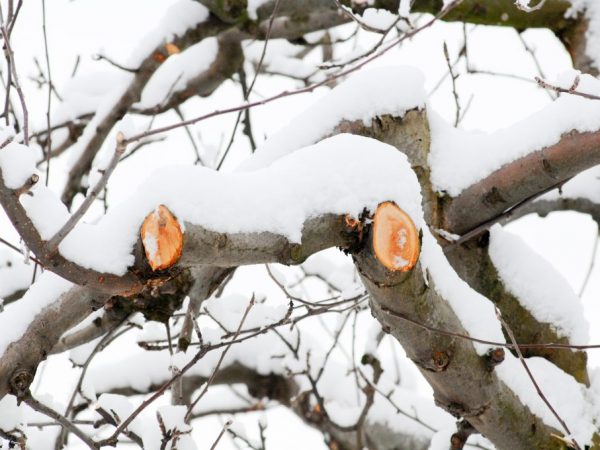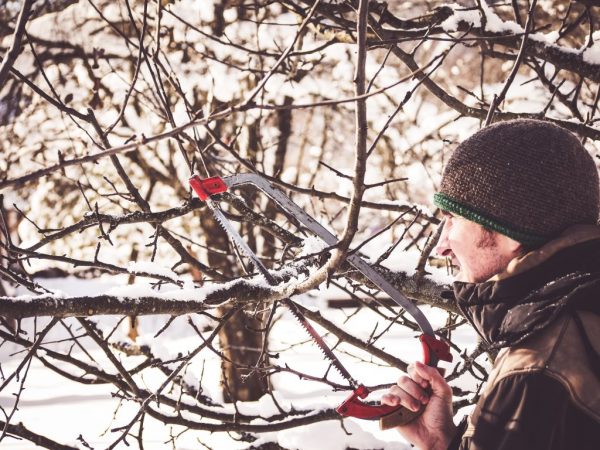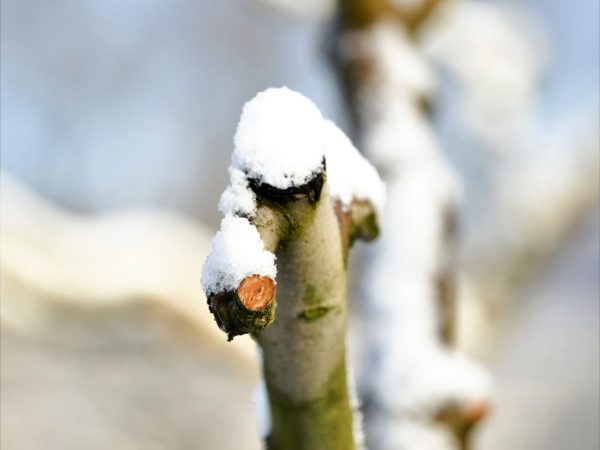Rules for pruning apple trees in winter
Pruning apple trees in winter is a mandatory step in shaping the crown of a tree. To harm the procedure, old and damaged branches are removed, this makes it possible for young seedlings to develop more actively. Thanks to the thinning of the crown, access to the sun's rays to the fruits is improved.

Rules for pruning apple trees in winter
Pruning tools
Winter pruning of apple trees involves the use of quality tools designed for such purposes. This will facilitate the gardener's work, and the pruning itself will be as gentle as possible for the plant.
The main garden tools for pruning branches:
- Pruner. It is a basic tool that any gardener should have. With its help, thinning of a highly branched, dense crown, as well as young seedlings, is carried out. The effectiveness of the pruner is undeniable: it can cut a large number of fruit trees in a short time. Distinguish between single and double-sided secateurs. The first is used for thin branches and shoots, and the second is used to remove old, diseased, thicker branches.
- Gardening scissors. They are great for trimming thin twigs.
- The gardener will need a garden saw (hacksaw) to remove branches that are more than 40 mm in diameter. You cannot use ordinary carpentry tools that will distort the cut point.
- The lopper performs the work inside the crown of the tree, in hard-to-reach places. This is the same pruner, but with long handles. It also performed well with thick branches. The sharp blades of this tool are coated with a special material that is easy to sharpen. A distinction is made between petrol or electric lopper models.
Tool requirements
When purchasing a garden tool, you need to focus on the amount of work: the number of trees, the diameter and number of branches, the presence of hard-to-reach places.
All devices for pruning apple trees (including winter ones) must meet the following conditions:
- meet high technical and hygienic requirements;
- work surfaces are made of quality materials;
- the blade on the device should be as sharp as possible, easy to sharpen, this will make it possible to get an even cut that minimally injures the tree;
- the ends of the blades of gardening tools are narrowed towards the edge, which allows them to be used in hard-to-reach places;
- convenience, safety, durability and low weight are essential characteristics of any device for these purposes;
- it is recommended to choose tools with a handle that is made of non-slip material, which will allow you to hold it securely in your hand (it is good when it has a bright, catchy color - this will allow you to quickly notice it if you have lost it).
Varieties of the procedure
Depending on the purpose, tree cleaning is divided into 4 types:
- rejuvenating - applied to adult, long-bearing apple trees;
- regulating - consists in the formation of the crown of the plant, its thinning;
- sanitary - with this treatment, dry, damaged or diseased branches are removed;
- restorative - after a bountiful harvest, strong winds, heavy snowfalls, damaged branches may remain that must be removed.
Cutting technology
For adult apple trees

Sawing off unnecessary branches
The technique by which the winter pruning of apple trees is carried out depends on the age of the fruit tree.
You also need to determine for what purpose it is carried out: as a sanitization, to form the upper part or to rejuvenate the culture.
In regions with a warm climate, pruning is carried out at the end of January, in cooler areas - in February - early March, until the buds swell.
Instructions for conducting
- When performing restorative or sanitary cleaning, a damaged or diseased branch is selected and cut off until healthy tissue appears.
- If, during the formation or thinning of the crown, the removal of a whole branch is required, it is cut off completely, but not into a ring, but with an indentation 15-20 cm above it.
- Pruning a branch with the transfer of subsequent growth to the bud provides for the removal of part of the shoot after it with a margin of at least 5 cm.
- If pruning is carried out with a saw, you first need to trim the branch from the back side, and then finish from the front side, this will prevent damage to the bark
- Cut off places must be covered with a special product (garden var, Ranet paste, Dobrosad).
Proper cleaning of apple trees will not allow frost to damage the cambia, which are located in those places where tissue scarring will take place.
With the arrival of heat, cut spots and cuts are quickly and successfully tightened.
Recommendations
The trimming tool is pre-sharpened and disinfected. Then the cuts will be even and infection will not occur.
For this procedure, choose a day with a temperature of 6 ° C, otherwise there is a risk of frostbite of the apple tree.
- Sick, old and dead branches are initially removed, regardless of their location.
- Shoots that grow inside the crown must be cut off.
- Densely growing shoots are cut off, which interfere with normal air circulation inside the crown. Excessive pruning will lead to increased growth of a large number of stepchildren.
- The branches, which are 2 years old, are shortened by ⅓ of their length, making a cut above the kidney.
- Young branches are also subject to removal, which direct growth into the crown, or are located in the immediate vicinity of skeletal branches.
- Large branches are removed one at a time each season.
- In winter, the clutches of harmful insects or stem diseases are especially noticeable on the trees. Such growths or pest nests should be trimmed or removed.
For young seedlings
Apple trees at the age of 1 to 3 years have not yet entered the fruiting phase, so pruning them is much easier than adult specimens. For thin branches, garden pruners are used.
The timing of pruning a young apple tree is late winter - early spring.
During this period, it is recommended to carry out exclusively sanitization of the culture, if it was not carried out in the fall.
In warm climatic zones, where winters are not particularly severe, crown formation can be carried out. The process is appropriate in cases where young shoots have formed on the seedlings, located parallel to each other, or the branches begin to grow inside the crown.
On the trunk, you need to leave 3-5 strong and healthy shoots, which are located in different places and grow in different directions, forming a wide angle in relation to the trunk. Sick, damaged and weak shoots must be removed.
4-5 buds are left on the side branches. With too active growth of the central shoot, it is shortened by 5-10 cm. All cut sites are treated with the same means as for adult trees.
Recommendations
It is better not to carry out winter pruning for seedlings younger than 3 years old.
A fragile plant can react negatively to it, which will have undesirable consequences.
Ideally limited to spring processing or winter cleaning.
Variants and schemes of the procedure
The formation of green mass must be carried out throughout the life of the apple tree.
This not only gives it a neat and aesthetically pleasing appearance, but also provides for regular rejuvenation, which significantly prolongs the period of its fruiting.
To choose the scheme and the most suitable crown shape, you need to focus on the type of culture, features of its structure, growth, etc.

We give a beautiful look
Tiered sparse
This method is considered one of the simplest; it will not be difficult to carry out such a crown formation even for a novice gardener. This scheme is suitable for large garden areas where trees grow at least 3 m apart.
With this shape of the crown, the branches are arranged in peculiar tiers that do not cover each other, but are arranged in a ladder order - one above the other. The appearance of such a tree looks natural.
Seasonal stages of crown creation
- Determine the stem and the first row of side branches 40-55 cm high from the root collar. Add another 25-30 cm to this height - this will be the crown. The entire plant that is located above must be removed.
- In the first row, two skeletal branches are left that grow in opposite directions. The distance between the upper and lower branches should be at least 15 cm. Unsuitable ones are removed, all others are shortened by ⅓.
- During this period, the formation of branching occurs on the lateral branches. The main branches are cut at a distance of 40-50 cm from the trunk. New shoots that have appeared in a year are removed.
- The final tier of the crown requires the formation of another lateral branch.
For all subsequent seasons, the form will no longer need to be changed. The crown, which increases annually in size, needs only thinning and shortening of young shoots.
Fusiform
The individuality of such a crown - the branches of a fruit tree are arranged in a spiral, if you connect them, the shape of the crown will resemble a spindle. The formation scheme is as follows:
- the gardener selects the main conductor, and tries to fix it in a strictly standing position;
- the height of the trunk from the root collar is 50-60 cm;
- the length of the main conductor must always be 2 times longer than the side branches;
- on the lowest branches there are 4-5 branches, on the middle ones - 1-3, and the top is the shortest.
Cupped
Most often, this scheme is used for undersized apple trees.
The formation of the crown in the first year is the same as with the longline method, but a significant difference lies in the location of the branches - they are bent to the ground at an angle of 120 ° with respect to the trunk.
The main conductor is removed completely to the base of the uppermost branch. Every year, the shape must be maintained by shortening the shoots and thinning them.
Vertical
The peculiarity of the apple tree crown in this shape is that it is unusual, the branches are in the same plane, but are located almost horizontally. The procedure for forming such a crown will take at least 4 years, it must be started already from the first year of the seedling's life.
The apple tree, the crown of which is formed according to this method, resembles a decorative figure located along the walls of houses and fences. Most often, the method is applied to weak trees, with fragile trunks that need support.
The palmette design looks like this: along the fence building or walls, a strong wire is pulled horizontally in rows. The distance between them is 40-45 cm, the uppermost row is located at the level of 2-2.5 m.
Seasonal sequence
- The seedling is shortened at a height of 50-70 cm. The central conductor is fixed to a vertical support, the lateral shoots are fixed in a horizontal position.
- Gradually growing lateral branches are fixed on the wire at the level of their growth. Excess lateral shoots are removed.This procedure is repeated annually.
Advantages and disadvantages of winter pruning
Winter is not always the best time to prune fruit trees.
It is believed that this is stress for the culture, and after the procedure, the plant will take a long time to recover.
But this is not entirely correct theory. In fact, winter pruning has several benefits.
- Stable vegetative dormancy of apple trees will prevent stressful situations, so they will endure pruning more calmly, without negative consequences and long-term recovery.
- In winter, trees are devoid of foliage, so it will be much easier to determine which branches are to be removed (full or partial).
- Gardeners have a lot of free time in winter, so choosing a day (s) convenient for pruning will not be difficult.
But the procedure still has disadvantages that need to be taken into account:
- in cold weather, it is inconvenient to use garden tools - hands are cold, body movements are shackled due to a large number of clothes;
- the wrong time (too low temperature) will cause frostbite in the sections.
An inept procedure will do more harm than good, so it is important for novice gardeners to listen to the recommendations and advice of practicing specialists.

